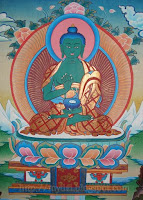 Amitabha is the most ancient Buddha among the five Dhyani buddha. He said to reside in the shukhavati heaven in peaceful meditation.
Amitabha is the most ancient Buddha among the five Dhyani buddha. He said to reside in the shukhavati heaven in peaceful meditation.The name Amitabha means "Infinite Light." Amitabha's Discriminating Wisdom conquers the poison of the passions--all cravings, covetousness, greed and lust. With this wisdom, the disciple discerns all beings separately yet knows every being as an individual expression of the One.
In the mandala of the Dhyani Buddhas or in Stupa, Amitabha is positioned to the west. His color is rose (red), the color of the setting sun. He rules over the element of fire and personifies the skandha of perception. Thus, the eye and the faculty of seeing are associated with Amitabha. The peacock, with "eyes" on its plumes, is his throne-bearer or vehicle. The peacock symbolizes grace.
Amitabha's symbol is the Padama or lotus, placed between him and Vairochana in mandala. In Buddhism, the lotus can symbolize many things, including spiritual unfoldment, purity, the true nature of beings realized through enlightenment, and compassion, the purified form of passion. Amitabha's female consort is Pandara.
Once Avalokiteshvara fainted, Buddha Amitabha said to him, "My son where has your courage, your mental strength gone?" Amitabha picked up all the pieces of Avlokiteshwor's body and the head. At the same time he said, "this happened because of your prayer. You deserve the praise of all Buddhas since your prayer was efficacious. However, noble son! Don’t worry." Read full STORY OF 1,000 ARMS AVLOKITESHWOR
Devotees aspire to be reborn in Amitabha's Western Paradise, known as Sukhavati, where conditions are ideal for attaining enlightenment.
His mudra is the dhyana (meditation) mudra. His bija is Hrih and his mantra is Om Amitabha Hrih.
Some consider Amitabha to be synonymous with Amitayus, the Buddha of Infinite Life. Others honor Amitayus as a form of Amitabha or as a separate Buddha. Amitayus is usually depicted holding a vessel of the elixir of immortal life. As shown in this statue, a tiny ashoka-tree often sprouts from the cover of his vessel, representing the union of the spiritual and the material.
Also Visit : The Five Dhyani Buddha ,
Dhyani Buddha Vairochana ,
Dhyani Buddha Akshobhya ,
Ratnasambhava



 Akshobhya is also one of the five Tathagatas or Dhyani Buddha, symbolizing Mirror like Wisdom (skt.adarsa jnana) which means the wisdom like space, all pervasive, without periphery and without character-istics. The name Akshobhya means "Immovable" or "Unshakable." Akshobhya's Mirrorlike Wisdom reflects all things calmly and uncritically and--reveals their true nature. He is the essence of purified form of Hatred. As in a mirror every visible object reflects so the knowledge of dharma-kaya reflects in our mind. Mirror like Wisdom antidotes the poison of hatred and anger.
Akshobhya is also one of the five Tathagatas or Dhyani Buddha, symbolizing Mirror like Wisdom (skt.adarsa jnana) which means the wisdom like space, all pervasive, without periphery and without character-istics. The name Akshobhya means "Immovable" or "Unshakable." Akshobhya's Mirrorlike Wisdom reflects all things calmly and uncritically and--reveals their true nature. He is the essence of purified form of Hatred. As in a mirror every visible object reflects so the knowledge of dharma-kaya reflects in our mind. Mirror like Wisdom antidotes the poison of hatred and anger.






 Each Buddha rules over one of the directions of space one of the cosmic realms of ether or space, water, earth, fire and air. The Dhyani Buddhas also personify the five skandhas, components that make up cosmic existence as well as human personality. These components are consciousness, form, feeling, perception and volition.
Each Buddha rules over one of the directions of space one of the cosmic realms of ether or space, water, earth, fire and air. The Dhyani Buddhas also personify the five skandhas, components that make up cosmic existence as well as human personality. These components are consciousness, form, feeling, perception and volition.


